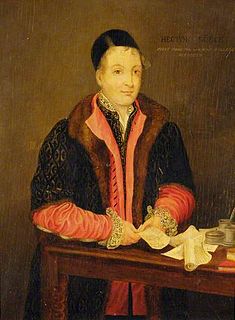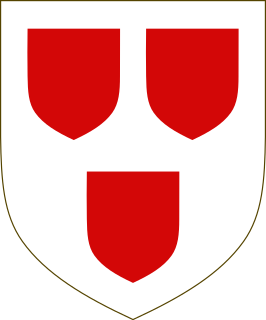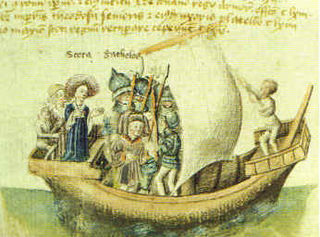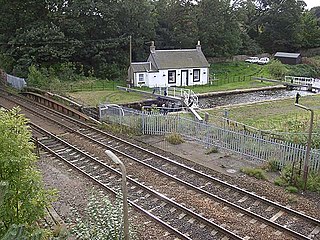Related Research Articles

Hector Boece, known in Latin as Hector Boecius or Boethius, was a Scottish philosopher and historian, and the first Principal of King's College in Aberdeen, a predecessor of the University of Aberdeen.

Lamlash is a village on the Isle of Arran, in the Firth of Clyde, Scotland. It lies three miles south of the island's main settlement and ferry port Brodick, in a sheltered bay on the island's east coast, facing the Holy Isle. Lamlash is the seat of Arran's local government offices, and is also the location of the island's only police station, secondary school and hospital. In common with the rest of the island, the village's main industry is tourism and the public sector is also an important employer. Lamlash has an RNLI Lifeboat station with a B class Atlantic 75 lifeboat, covering the inshore waters around the coast of Arran, and in summer, there is a regular ferry service from Lamlash harbour to Holy Isle. The village has several buildings of historical interest, including Hamilton Terrace, which consists of two rows of idyllic single storey-and-attic cottages on the Lamlash seafront, arranged in pairs.

William Elphinstone was a Scottish statesman, Bishop of Aberdeen and founder of the University of Aberdeen.

Irvine is an ancient settlement, in medieval times a royal burgh, and now a new town on the coast of the Firth of Clyde in North Ayrshire, Scotland. The 2011 Census recorded the town's population at 33,698 inhabitants, making it the largest settlement in North Ayrshire. Irvine was the site of Scotland's 12th century military capital and former headquarters of the Lord High Constable of Scotland, Hugh de Morville. It also served as the capital of Cunninghame and was, at the time of David I, Robert II and Robert III, one of the earliest capitals of Scotland.
Beith is a small town in the Garnock Valley, North Ayrshire, Scotland approximately 20 miles south-west of Glasgow. The town is situated on the crest of a hill and was known originally as the "Hill o' Beith" after its Court Hill.

The Lia Fáil is a stone at the Inauguration Mound on the Hill of Tara in County Meath, Ireland, which served as the coronation stone for the High Kings of Ireland. It is also known as the Coronation Stone of Tara. According to legend, all of the kings of Ireland were crowned on the stone up to Muirchertach mac Ercae, c. 500 CE.

Clan Hay is a Scottish clan of the Grampian region of Scotland that has played an important part in the history and politics of the country. Members of the clan are to be found in most parts of Scotland and in many other parts of the world. However, the North East of Scotland, i.e. Aberdeenshire (historic), Banffshire, Morayshire and Nairnshire Nairn (boundaries), is the heart of Hay country with other significant concentrations of Hays being found in Perthshire, especially around Perth, in the Scottish Borders, and in Shetland.

Scota and Scotia are the names given to the mythological daughters of two different Egyptian pharaohs in Irish mythology, Scottish mythology and pseudohistory. Though legends vary, all agree that a Scota was the ancestor of the Gaels, who traced their ancestry to Irish invaders, called Scotti, who settled in Argyll and Caledonia, regions which later came to be known as Scotland after their founder.

Dunstaffnage Castle is a partially ruined castle in Argyll and Bute, western Scotland. It lies 3 miles (5 km) NNE of Oban, situated on a platform of conglomerate rock on a promontory at the south-west of the entrance to Loch Etive, and is surrounded on three sides by the sea. The castle and the nearby chapel ruin have been a Historic Scotland property since 1958. Both are Scheduled Ancient Monuments.

Dunbeg, formerly known as Dunstaffnage, is a village about 2+1⁄2 miles (4 km) outside of Oban, Scotland. It has a population of just under 1,000. It is home to the Scottish Association for Marine Science (SAMS), one of the primary marine science centres in the UK. Also near Dunbeg is Dunstaffnage Castle, part of the Campbell Clan and is owned by the Captain of Dunstaffnage.

Camelon is a large settlement within the Falkirk council area, Scotland. The village is in the Forth Valley, 1.3 miles (2.1 km) west of Falkirk, 1.3 miles (2.1 km) south of Larbert and 2.6 miles (4.2 km) east of Bonnybridge. The main road through Camelon is the A803 road which links the village to Falkirk. At the time of the 2001 census, Camelon had a population of 4,508.
Luncarty ) is a village in Perth and Kinross, Scotland, approximately 4 miles north of Perth. It lies between the A9 to the west, and the River Tay to the east.

Redgorton is a settlement in Gowrie, Perth and Kinross, Scotland. It lies a few miles from the River Tay and the A9 road, across the latter from Luncarty. It lies close to the Inveralmond Industrial Estate.

The Battle of Barry is a legendary battle in which the Scots, purportedly led by Malcolm II, defeated a Danish invasion force in 1010 AD. Its supposed site in Carnoustie, Angus can be seen in early Ordnance Survey maps. The history of the event relies heavily on tradition and it is currently considered to be apocryphal. The battle was named for the Parish of Barry, rather than the village, and was formerly thought to have taken place at the mouth of the Lochty burn, in the vicinity of the area that is now occupied by Carnoustie High Street. While the battle is not historically authentic, its romantic appeal continues to capture the popular imagination.
Camus, in historic literature, was a Scandinavian general dispatched to engage the Scots in battle, reportedly in the early eleventh century AD. The legendary engagement was called the Battle of Barry, and was first alluded to by Boece.
The Battle of Duns or Battle of Duns Park was an engagement fought in 1372 near the site of the present day town of Duns, Berwickshire.

The Camus Cross, otherwise known as the Camuston or Camustane Cross, is an Early Medieval Scottish standing stone on the Panmure Estate near Carnoustie in Angus, Scotland. First recorded in the 15th century in a legal document describing the boundaries between Camuston and the barony of Downie, and described in the 17th century by Robert Maule, it is a freestanding cross, rare in Eastern Scotland.

The Aberlemno Sculptured Stones are a series of five Class I and II Early Medieval standing stones found in and around the village of Aberlemno, Angus, Scotland.
Events from the year 1951 in Scotland.
Events from the year 1950 in Scotland.
References
- ↑ Boece of Dundee, Hector (1575). The History of the Scots from Their First Origin . Retrieved 2 September 2014.
- ↑ Skene, William F. (7 June 1869). The Coronation Stone. Edinburgh: Edmonston & Douglas. p. 14. Retrieved 2 September 2014.
- ↑ Cowing, Emma (19 December 2010). "Stone of Destiny 'from Ayrshire, not Perthshire'". Scotland on Sunday . Archived from the original on 21 December 2010. Retrieved 2 September 2014.